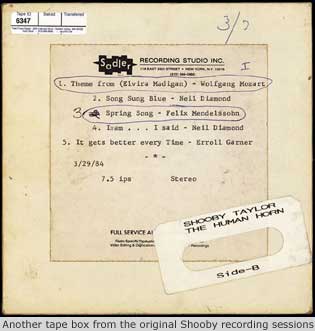|
||||
|
| . | . |
APRIL 15, 2004 Cory Brown insisted on getting a project blessing from William Taylor, Jr., who would also be offered royalties on the release. I warned Cory, based on my one call to the younger Taylor, that he was volatile and unreceptive to inquiries about his father. However, Brown resolved to make an attempt at contact. He called WT Jr., who seemed surprisingly receptive and eager to speak with me. His mood had changed significantly since our previous phone debacle. I called WT Jr. and we spoke. It was short and sweet, perhaps five minutes. He said, numerous times, "Irwin, you're my man." He insisted that he wouldn't do anything without first consulting me. This was more than expected, and he assented to our project. He did most of the talking, in a compulsive, high-strung manner, but signaled that he didn't want to stay on the phone long either. In the course of the conversation, he revealed that he had his father's master reels from studio sessions. I was shocked and elated. He explained that some time ago Shooby had given him the tapes "for safekeeping." (William Jr. had no idea what became of the cassettes and CDs in his father's former Newark apartment.) I agreed to pick up the tapes in the near future, and thanked him for his understanding and cooperation. NOVEMBER 5, 2004 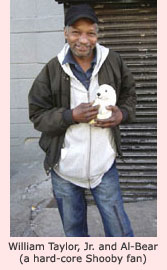 On a crisp, 55-degree autumn afternoon, my pal Barbara Economon and I drove from NJ across the GW Bridge, down the Henry Hudson to Harlem. Mission -- to meet William Taylor, Jr. and collect the Shooby Taylor "archives." We had no idea what condition the tapes -- or William Jr. -- were in.
On a crisp, 55-degree autumn afternoon, my pal Barbara Economon and I drove from NJ across the GW Bridge, down the Henry Hudson to Harlem. Mission -- to meet William Taylor, Jr. and collect the Shooby Taylor "archives." We had no idea what condition the tapes -- or William Jr. -- were in.We drove east to St. Nicholas Avenue. On the phone, I asked William if we should ring the bell. In his typically slurred-but-cordial manner, he said, "I'll be out on the street." "With the tapes?" "Yeah. I'll be hanging out there." In the car CD deck: the Chambers Brothers album The Time Has Come, featuring the song "Uptown," about "going uptown to Harlem." We needed a soundtrack. Steely Dan in a pinch: "Daddy don't live in that New York City no more." We left-turned on St. Nick and there he was -- pacing the sidewalk alone, part of the urban streetscape. We parked, got out, and he flashed a LARGE smile. He gripped a bulky Duane Reade shopping bag filled with 1/4-inch tape boxes. At the bottom of the sack were three books of matches, a lighter, and some dead bugs. Barb took snapshots during the handoff, as I rummaged through the bag. It contained four 10" reels, eleven 7" reels, and three 5" reels. The cartons were relatively clean, and in decent shape. The tapes looked as if they hadn't been unspooled since the day they were recorded and stored tails out, leader anchored to the reel with a small strip of adhesive. Very little information on the boxes. Some studio paperwork inside, but again, little info. Some were dated -- the earliest, 1975, the latest, 1984. Some had track titles, others none. All notation was written by hand, in pen or grease pencil. One box cover indicated simply, "He does it all." Another said: SHOOBY TAYLOR
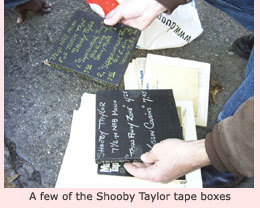 NOVEMBER 11, 2004 NOVEMBER 11, 2004Preliminary effort to catalogue (but not listen to) the tapes. Not a lot of helpful info. What's written appears largely to be in Shooby's scrawl. Studios identified: Sadler Recording, Stelwill Sound, Nola Sound Studios. Curiously, no mention of Angel, though at least half the tapes have no studio identifier. "Collaborative" artists listed:
Only five of 18 tapes were dated -- the earliest March 18, 1975, the latest March 29, 1984. All are quarter-inch, recorded at 7-1/2 ips. They appear clean and well-preserved, likely having not been played in several decades. NOVEMBER 16, 2004 Took several tapes over to buddy R. Stevie Moore's apartment for review. They rolled -- though increasingly sluggishly, as grime collected on the playback heads. What I heard, in brief, were some early '70s hot funky (pre-disco) jams with Shooby nicely mixed and wailing in top form. Exciting! Quickly took the tapes off to avoid possible damage. Ready to schedule studio transfers. NOVEMBER 23, 2004 Confirmed arrangements with Chris Strouth of Innova Records/Composers Forum to bring the Shooby tapes into a Minneapolis studio in January under a new grant program for recording projects. JANUARY 17, 2005 Spoke with Paul Stark, founder of Twin Tone Records (The Replacements, Soul Asylum, Ween, etc.). Paul undertook the assignment of "baking" the Shooby tapes (which had been shipped to him two weeks earlier). In this process, vintage open-reel tapes are prepared for transfer by literally cooking them in an oven at a set temperature for a particular length of time. This hardens the tape emulsion and prevents gook from mucking up the playback heads, which would otherwise prevent proper speed playback (or playback, period). How this formula evolved you can Google in your own time (OK, I did it for you), but it works. Paul said he'd used it to great effect on old Twin Tone tapes. His former employee, Chris Strouth, now of Innova and Composer's Forum (who are underwriting studio time for the Shooby restorations), had tapped Paul to perform this preservation work on the Taylor reels. Paul was happy to report that all tapes were successfully baked and transferred to digital discs. He explained that he'd listened to all the recordings -- around 90 songs, he estimated -- and was amazed at what he'd heard. (He knew nothing of the back story.) Was it agonizing or cathartic, I inquired, having prolonged exposure to Shooby? Paul claimed he could pass an hour and a half at a stretch before needing relief. Spoke to Chris Strouth, who confirmed that studio time in Minneapolis is arranged and an engineer has been assigned. JANUARY 19, 2005 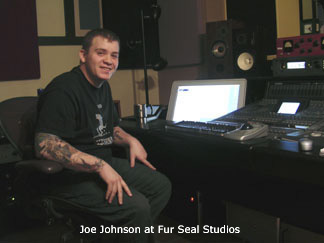 Fur Seal Studios, Minneapolis Fur Seal Studios, MinneapolisJoe Johnson, Logan Erickson, engineers The studio is very homey, based in a carriage house in a residential neighborhood. Fur Seal Studio was owned by singer / songwriter / musician (and Twin City Hide scion) Jonathan Grove, who passed away Nov. 24, 2003, at age 44, of cancer. Grove's stock holdings in the family business were used to endow a grant program subsidizing recording projects at Fur Seal. Composer's Forum was asked to administer the process. I am the "guinea pig" (Strouth's reference), the first "official" underwritten project. Stark supplied 18 files (one per tape), containing single summed stereo files (as opposed to two mono tracks), converted to two mono WAVE work files. Engineers Joe and Logan had not previously been exposed to the Shooby mojo. They were enraptured with Taylor's outbursts. More often than not, anyway. OK, there were moments of duress. We spent the day reviewing and cataloging the recordings, which sounded crisp and alive -- and for the most part, pristine. A few drop-outs, a little tape bleed-through, but amazingly more well-preserved than expected. Shooby's mouth noises were audible as he warmed-up his "horn" during instrumental intros. We identified song titles and, where possible, artists on source recordings. We ID'ed about 90% of the material. There was more Shooby live in the studio with keyboardist Fredy Drew, but mostly his music beds were commercial LPs. Some of the best stuff featured Shooby grooving with Dexter Gordon and Erroll Garner, respectively. There was some additional "classical" repertoire. We couldn't contain our laughter hearing Shooby wail over an unidentified "Pops" version of Mendelssohn's "Spring Song," or the "Theme From Elvira Madigan." Taylor's stamina was superhuman. He was overweight at the time of these recordings. He should've run out of breath, but he never flags. His voice doesn't give out; he never sounds winded. "Balls to the wall," Joe noted. "He doesn't leave spaces like Miles Davis." Shooby is indeed ambitious. He's rarely inclined towards nuance, preferring high-octane showmanship. I'm not sure what Leonard Cohen's "jazz police" would make of this stuff. Shooby was a genius and a crackpot -- sometimes both simultaneously. It's easy to make the case that his performances are benignly deranged, insofar as they often disrespect the songs he scats over. But he had a jazz soul, and jazzbos toy with compositions and transform them, often into unrecognizable forms. Taylor excels on instrumentals, in which he's another instrument in the ensemble. The original 1970s and '80s mixes are surprisingly well-balanced. He must've been assigned good engineers. Shooby hits his stride with Erroll, Dexter and Miles, competing with saxes, trumpets and trombones. Well, he WAS the human horn. He sprints with the rhythm as befits the composition, and (except with Erroll Garner) often lays out for piano, bass and drum solos. Craig Bradley had observed that at Angel Sound Shooby recorded everything in one take. Yet it's obvious that Taylor had practiced and knew every verse, chorus, bridge and extended solo. Despite Taylor's reputation for absurdity, only about a quarter of these recordings seem irredeemably clownish. Taylor is most ridiculous when scatting over vocals (e.g., Johnny Cash, Shirley Caesar, Charley Pride, Elvis). He respects Dexter Gordon while expressing implicit contempt for Johnny Cash. He lets Dexter take 32 bars but won't leave Cash alone for a single verse. Sometimes Shooby steps on the song, and sometimes the song retaliates. This is Taylor at his most deluded and unintentionally comical, though his joy is infectious. He's a dominant character. He lumberjacks his way through the forest, clearing all in his path. These recordings, when released, will shock. Shooby's fans will be jubilant. Scoffers will feel affirmed. Journalists will marvel. Wait'll they hear Shooby scatting over Mozart and Mendelssohn. Graves will be disturbed. As are angels, somewhere, at this very moment. JANUARY 20, 2005 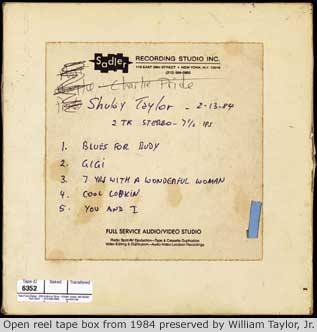 Fur Seal Studios, Minneapolis Fur Seal Studios, MinneapolisAdded eight tunes of Shooby with Erroll Garner, which were not found among the 18 tapes. This session was preserved from a cassette Rick Goetz and I salvaged from Shooby's apartment in '02. We selected tracks for album consideration, basically separating the great from the -- less great. There's about two albums' worth of first-rank recordings (pending licensing hurdles): 39 tracks, totaling about 132 minutes. A third album wouldn't be a huge qualitative step down, either. The Horn blew consistently. We did some fixes. Engineers Joe and Logan were brilliant in this regard, particularly on repairing audio dropouts. They corrected channel imbalances, removed vinyl clicks and pops, but didn't do much EQ (adjusting the sonic spectrum). We left intact Shooby's audio flaws (e.g., mouth noises, mic pops, overmodulation, coughs), which are part of the charm. Taylor's timing is erratic, depending on his mood or voice condition at each session. He's sometimes in the groove, at other times strains but doesn't quite jive. His riffs vary. You could probably chart Shooby's artistic growth from 1975 to 1984 (but the Fur Seal grant won't cover it). He's great when he growls, or gooses a high note. Taylor hunkers down and begins riffing, and just when you think he's in a rut, he uncorks a vocal bottle rocket that scorches your earlobe. In cases where singers ease into ritardando at codas, Shooby rarely slows down, but instead races the vocalist to the finish line. His scat vocabulary is stunning, although he does have favorite "shyllables." There's something intrinsically Hebraic about his linguistics. What we found on these tapes is mesmerizing and historic, demonstrating the eccentric -- and extensive -- genius of Mr. Taylor. He left behind a monumental legacy. It's a miracle (several, in fact) that these relics survived. It's a thrill to work on this project, paying tribute to the music and the character who made it. I'm in greater awe of Shooby than ever before. AUGUST 18, 2005 Cory Brown (of Absolutely Kosher Records) and I have requested licenses from major labels for the master recordings underlying Shooby's manic scats. The original recordings (but not Shooby's value-added swoops) are owned by the likes of Sony-BMG, Universal, EMI, and Warner Bros. These leviathans have more seismic concerns than our bottom-feeder licensing applications, and we have no illusions otherwise. But we intend to pursue these usages legally, and conclusively. We could have released a 5,000-unit run below the majors' radar, but as Cory put it, "You have to plan for success." We don't foresee Grammy-grade sales, but such an idiosyncratic release will attract curious journalists, which in turn could draw attention from the copyright police. If we get pulled over, we want to flash the law a valid license and registration. (Shooby, of course, does not obey speed limits.) We'd hoped to get approvals wrapped in time for a late 2005 stocking stuffer, but progress has proceeded glacially, so we're penciling in Spring 2006. However, any timetable is iffy. Noted Dutch designer Piet Schreuders has agreed to create the package. Schreuders has fashioned dozens of spectacular albums for the Basta label, as well as publishing his own periodicals (Die Poezenkrant, Furore), authoring three books, and being one of the foremost researchers of Hal Roach comedies. Piet's been a Shooby fan for over a decade, and humbly requested the assignment. Cory and I have selected 21 tracks. If we fail to obtain licenses for particular masters, we've flagged alternates. We're expecting a few rebuffs; in some cases final approval for usage is vested with deceased performers' heirs, who might interpret Shooby's hi-octane histrionics as "disrespectful" to the original artists. We haven't encountered that reaction yet, because we're not that far along in the licensing process. But we won't be surprised if someone declares "sacrilege." Considering what Taylor did over Johnny Cash, we've had that thought ourselves. Here is the first-tier track selection, along with the original recording artists and year of original LP issue:
SEPTEMBER 15, 2005 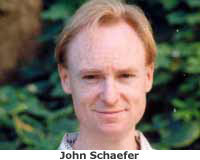 This afternoon I was a guest on John Schaefer's WNYC radio show, Soundcheck, where we discussed Shooby Taylor and Jandek, and aired excerpts from their recordings. The program archive can be heard here. This afternoon I was a guest on John Schaefer's WNYC radio show, Soundcheck, where we discussed Shooby Taylor and Jandek, and aired excerpts from their recordings. The program archive can be heard here.The interview takes place in the second half of the program. The first half was devoted to a remarkable performer named Charles Ross, who has an off-Broadway show in which he re-enacts -- solo, without props -- all dialogue from the first three Star Wars films in one hour. He demonstrates this remarkable virtuosity during his interview. LICENSING UPDATE: We're still following through on various inquiries to business affairs departments of major labels who own the underlying master recordings. We're talking to licensing administrators, some of whom get Shooby and want to help, while a few figuratively yawn and toss our letters in their overflowing inboxes. This is neither good news nor bad news; it's business as usual. |
|||||
|
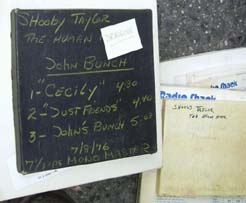
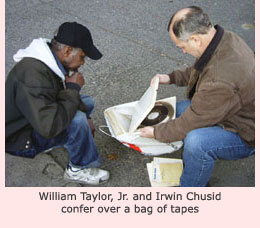 I recognized a number of titles from the cassettes Rick had transferred, saw a few unfamiliar titles, and noticed a few known titles missing. But considering the age and journey of these tapes, they appeared to be in surprisingly good condition. (Which doesn't mean the audio has been well-preserved. That remains to be determined.)
I recognized a number of titles from the cassettes Rick had transferred, saw a few unfamiliar titles, and noticed a few known titles missing. But considering the age and journey of these tapes, they appeared to be in surprisingly good condition. (Which doesn't mean the audio has been well-preserved. That remains to be determined.)